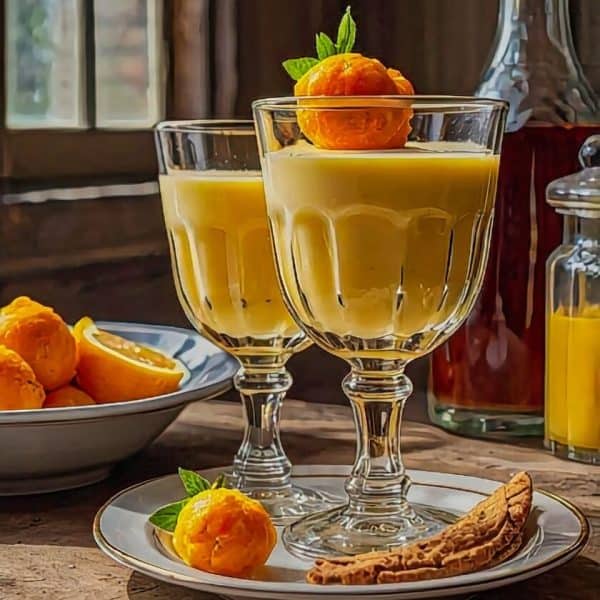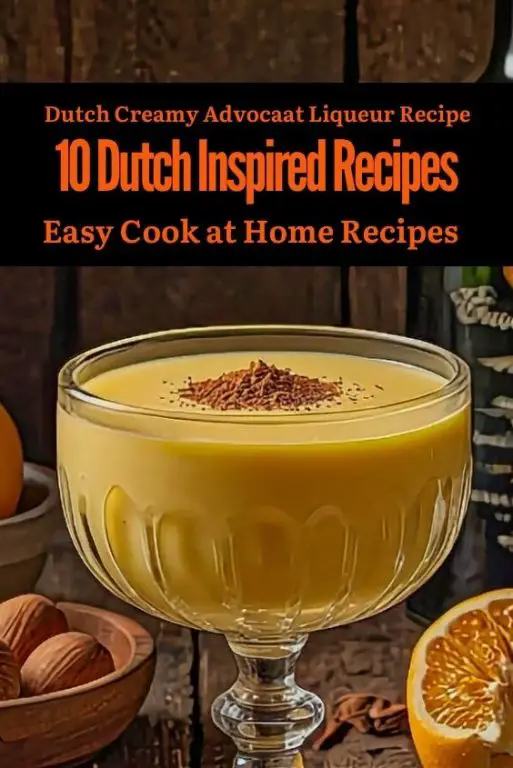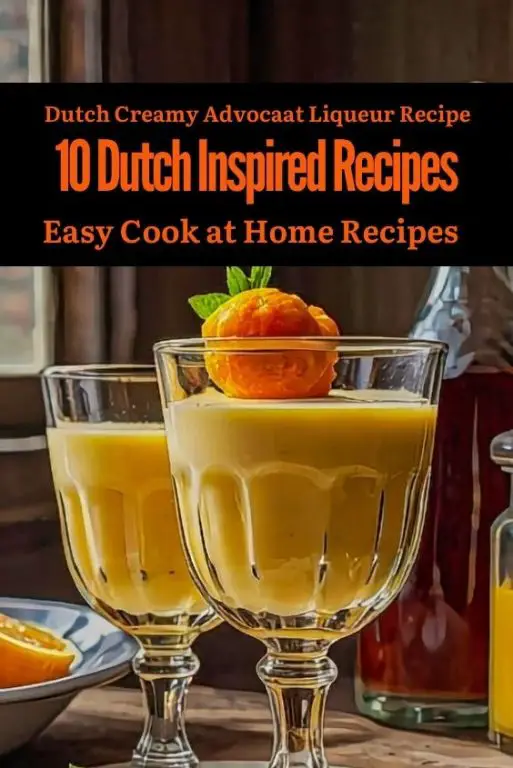The Dutch Creamy Advocaat Liqueur recipe was the star of one of the most enjoyable food tours I’ve ever experienced in Amsterdam. As we walked through the city’s cute streets, we were all eager to try the best places to eat, from secret cafes to local markets. One interesting thing, though, was learning from a local expert how to make the famous Dutch Creamy Advocaat Liqueur.
We got together in a cozy café and were introduced to advocaat, a rich and silky egg-based liqueur that is usually drunk with a spoon or mixed into cocktails. The group couldn’t stop talking about how smooth and custard-like it was. We all had a good time tasting it and learning about the interesting history behind its making. The Dutch Creamy Advocaat Liqueur recipe wasn’t just given to us; we were shown how to make it, which helped us understand all of its parts better.
Some great tips for getting ready that really make a difference were a big part of the tour’s fun. For example, we were told that mixing the ingredients over a low, slow heat is the key to getting that creamy, smooth texture. It makes sure the mix stays soft and doesn’t curdle, which is something that many people do wrong. The teacher also said that using fresh ingredients and good eggs makes the end taste better. With these little tips, the drink seemed much less complicated and more doable.
While we were trying the Advocaat and taking notes, we had a lot of fun. One of the best parts was when someone else on the tour tried to explain how advocaat is made correctly: it’s thick enough to hold a spoon straight but smooth enough to slide down without any trouble. Everyone tried their hand at it, and it was fun to see how long we could keep the spoon from falling over.
Our food tour of Amsterdam was full of more than just great food. The rich taste of the Dutch Creamy Advocaat Liqueur recipe and the process of making it made the experience even more memorable. If you ever go to Amsterdam, you should try it. Also, don’t forget to get the recipe so you can bring a bit of Dutch custom back home with you!
Ingredients For the Dutch Creamy Advocaat Liqueur Recipe
Egg Yolks
Sugar
Rum
Brandy
Heavy Cream
Vanilla Extract
Cooking Instructions For the Dutch Creamy Advocaat Liqueur Recipe
- In a mixing bowl, beat the egg yolks until they are light and fluffy. Add sugar to the egg yolks and continue to beat until the mixture becomes thick and creamy. Slowly pour in the rum and brandy while stirring the mixture.
- Heat the mixture in a saucepan over low heat, stirring constantly to avoid curdling. Keep stirring until the mixture thickens and coats the back of a spoon. Remove the mixture from heat and let it cool to room temperature.
- Once cooled, add whole milk or heavy cream and vanilla extract to the mixture. Stir until the ingredients are well combined. Pour the mixture into a sterilized bottle and chill in the refrigerator before serving.
Foods Most Eaten by Dutch Locals
Dutch cuisine is simple yet rich in flavors, deeply rooted in the country’s agricultural history. While the Netherlands may not be as famous for its food as some other European nations, locals enjoy a variety of hearty, filling dishes that reflect their love of comfort foods and fresh ingredients.
Stamppot is a beloved winter dish that locals enjoy regularly. It consists of mashed potatoes mixed with vegetables such as kale, carrots, or sauerkraut. It’s typically served with a smoked sausage known as rookworst, adding a savoury, warming element to the meal.
Another common food is haring, or raw herring, which the Dutch traditionally eat with chopped onions and pickles. Locals celebrate Vlaggetjesdag, or Flag Day, each year to mark the start of the herring season. The fish is eaten whole or on a bun, and it’s considered a delicacy by many.
Poffertjes are a sweet treat found at markets and festivals across the Netherlands. These small, fluffy pancakes are served with powdered sugar and butter, making them a popular choice for dessert or an afternoon snack.
For a quick lunch, locals often turn to broodje kroket, a sandwich made with a crispy croquette filled with meat ragout. You’ll find this in cafés and vending machines around the country, where it’s enjoyed on the go.
Gouda cheese, one of the world’s most famous, is also a staple in Dutch households. Eaten at breakfast, lunch, or dinner, it’s an important part of the Dutch diet, often paired with bread or melted over dishes.
These are just a few examples of the foods commonly enjoyed by the Dutch, highlighting the simplicity and heartiness of their cuisine.
5 Essiential Ingredients for Dutch Style Food
Dutch cuisine is known for its simplicity and reliance on fresh, locally sourced ingredients. Whether you’re making hearty winter stews or traditional sweets, certain ingredients are key to capturing the essence of Dutch food. Here are five essential ingredients used in many Dutch-style dishes:
1. Potatoes (Aardappelen)
Potatoes are a staple in Dutch cooking, forming the base of many classic dishes.
The most famous dish featuring potatoes is Stamppot, a traditional meal of mashed potatoes mixed with vegetables like kale (boerenkool) or carrots and onions (hutspot).
Potatoes are also used in patat, the Dutch version of French fries, which are often served with mayonnaise or peanut sauce.
You’ll also find them in erwtensoep, a thick pea soup served with chunks of potato and sausage.
2. Herring (Haring)
Herring, a type of oily fish, plays an important role in Dutch cuisine, especially as a popular street food.
The most traditional way to enjoy herring is raw, typically with chopped onions and pickles. Locals often eat it by holding the fish by the tail and sliding it into their mouths.
Herring is also served on a sandwich, called a broodje haring, often with the same onions and pickles.
It’s available year-round but is especially celebrated in spring during Vlaggetjesdag (Flag Day), which marks the beginning of the herring season.
3. Cheese (Kaas)
The Netherlands is world-renowned for its cheeses, with Gouda and Edam being the most popular.
Cheese is a key part of the Dutch diet, often eaten with bread for breakfast or lunch. It’s also
featured in snacks like kaasstengels (cheese sticks) and kaassoufflé (deep-fried cheese pastry).
Dutch cheese is known for its smooth texture and mild flavor, although aged varieties can have a stronger, more complex taste.
In addition to Gouda and Edam, cheeses like Leiden and Maasdam are also widely used in various dishes or as stand-alone snacks.
4. Butter (Boter)
Butter is a central ingredient in Dutch cooking, especially in baked goods and desserts.
Traditional Dutch pancakes, or pannenkoeken, are fried in butter to give them a rich flavor. Butter is also used in poffertjes, small fluffy pancakes served with powdered sugar.
In many Dutch households, butter is spread thickly on bread, often topped with cheese, chocolate sprinkles (hagelslag), or jam.
Dutch butter is creamy and slightly salty, adding richness to both savory and sweet recipes.
5. Speculaas Spices (Speculaaskruiden)
A blend of warm spices, speculaaskruiden is essential in creating the flavors of Dutch baked goods, particularly around the holidays.
The spice mix typically includes cinnamon, nutmeg, cloves, ginger, cardamom, and white pepper.
Speculaas, a spiced shortcrust biscuit, is a popular Dutch treat, especially during Sinterklaas, a Dutch holiday celebrated in December.
These spices are also used in recipes for gevulde speculaas (filled spice cake), pepernoten (spiced cookies), and other Dutch pastries.
Dutch cuisine is simple yet satisfying, and its unique flavors stem from the combination of these essential ingredients. Potatoes provide the base for hearty meals, herring brings a taste of the sea, and Dutch cheese adds richness to daily snacks and dishes. Butter enhances both savory and sweet treats, while speculaas spices bring warmth and tradition to festive baked goods. Incorporating these ingredients is key to mastering Dutch-style cooking.
FAQ For the Dutch Creamy Advocaat Liqueur Recipe
Q: What are the key ingredients needed for a Dutch Creamy Advocaat Liqueur recipe?
A: A traditional Dutch Creamy Advocaat Liqueur recipe typically includes egg yolks, sugar, brandy, and vanilla extract. These ingredients create the rich, velvety texture and sweet, custard-like flavour that Advocaat is known for. The egg yolks give the liqueur its signature creaminess, while the brandy adds a slight alcoholic warmth. The vanilla extract enhances the overall flavour, making it a delightful and indulgent treat for those who enjoy rich, creamy beverages.
Q: Can I make the Dutch Creamy Advocaat Liqueur recipe without alcohol?
A: Yes, you can adapt the Dutch Creamy Advocaat Liqueur recipe to be alcohol-free by replacing the brandy with a non-alcoholic substitute, such as a combination of apple juice or white grape juice with a splash of vanilla extract. While the flavour will be slightly different from the traditional version, it will still have the creamy texture and sweet taste that makes Advocaat enjoyable. This non-alcoholic version is great for serving to guests who prefer alcohol-free beverages. You can enjoy the same luxurious drink experience without the alcohol content.
Q: How long does homemade Dutch Creamy Advocaat Liqueur last in the refrigerator?
A: When stored properly in an airtight container, homemade Dutch Creamy Advocaat Liqueur can last in the refrigerator for up to two weeks. The alcohol content acts as a preservative, but because it contains raw eggs, it’s important to keep it chilled at all times. Before serving, be sure to give it a good shake as the ingredients can sometimes separate during storage. If you notice any changes in smell or texture, it’s best to discard the batch for safety reasons.
Q: What is the best way to serve Dutch Creamy Advocaat Liqueur from the recipe?
A: Dutch Creamy Advocaat Liqueur is traditionally served as a sipping liqueur in small glasses, often topped with a dollop of whipped cream and a dusting of cinnamon or nutmeg. You can also use the Dutch Creamy Advocaat Liqueur recipe as a base for various cocktails, such as a Snowball, where it’s mixed with lemonade or soda for a refreshing twist. It’s also popular as a dessert topping or mixed into coffee for a decadent treat. Whether enjoyed straight or in a cocktail, it’s a luxurious addition to any occasion.
Q: Can I adjust the sweetness level in the Dutch Creamy Advocaat Liqueur recipe?
A: Yes, the sweetness in the Dutch Creamy Advocaat Liqueur recipe can be easily adjusted to your taste. If you prefer a less sweet version, simply reduce the amount of sugar used in the recipe. You can also experiment with alternative sweeteners, such as honey or maple syrup, for a different flavour profile. The balance between the sugar and brandy is essential to ensure the liqueur maintains its creamy consistency, so make adjustments gradually and taste as you go. This flexibility allows you to customize the liqueur to your personal preferences.

Dutch Creamy Advocaat Liqueur
Equipment
- mixing bowl
- Hand mixer or whisk
- Saucepan
- Wooden Spoon
- Sterilized bottle for storing the liqueur
Ingredients
- 8 egg yolks
- 1 cup sugar
- 1 cup rum
- 1 cup brandy
- 1 cup whole milk or heavy cream
- 1 tsp vanilla extract
Instructions
- In a mixing bowl, beat the egg yolks until they are light and fluffy.
- Add sugar to the egg yolks and continue to beat until the mixture becomes thick and creamy.
- Slowly pour in the rum and brandy while stirring the mixture.
- Heat the mixture in a saucepan over low heat, stirring constantly to avoid curdling.
- Keep stirring until the mixture thickens and coats the back of a spoon.
- Remove the mixture from heat and let it cool to room temperature.
- Once cooled, add whole milk or heavy cream and vanilla extract to the mixture.
- Stir until the ingredients are well combined.
- Pour the mixture into a sterilized bottle and chill in the refrigerator before serving.





3 comments
I made the Dutch creamy advocaat liqueur recipe, and it turned out fantastic! The texture was smooth and velvety, with a rich and custard-like consistency. The blend of eggs, sugar, and brandy created a drink that was sweet but not overly so. It’s perfect for sipping after dinner or even using as a dessert topping. I will definitely make it again, especially around the holidays.
I cant believe they didnt include any serving suggestions for the Dutch Creamy Advocaat Liqueur recipe! How am I supposed to know if it pairs better with dessert or as a standalone drink? Disappointed!
I cant believe they didnt mention adding a splash of vanilla extract to the Dutch Creamy Advocaat Liqueur recipe! It takes it to the next level. Trust me, you wont regret it.